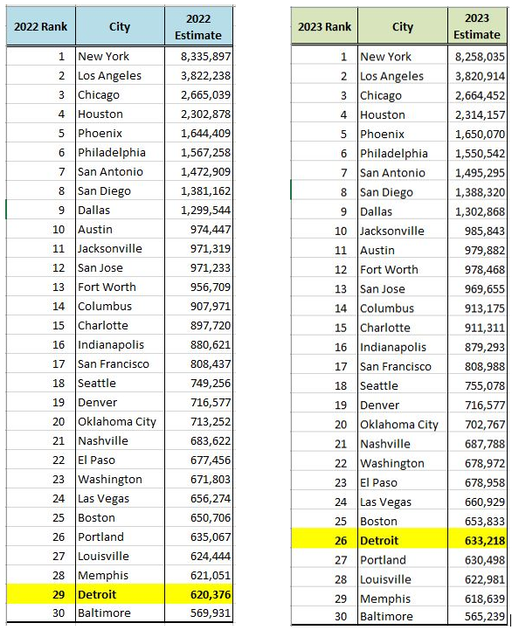Latest Post
Detroit Has To Grow
Turning an Aircraft Carrier Around
September 16, 2024

According to the US Census, Detroit began to grow in 2023, the total population going up by about 13,000. In 2022, Detroit came in as the 29th largest city in the US with a total population of 620,376), and in 2023, the population clocked in at 633,218, placing us at 26th. This is a huge victory for our city, and one that city government needs to double down on.
The population of Detroit crested in the mid 1950s at about 1.8 million. We are down by two thirds since our historic high water mark, and though the gain we’ve seen in the past couple of years is relatively minor, reversing years of population growth is like turning around an air craft carrier. There is much to be proud of, and much to celebrate in this. If Detroit can keep this rate of growth up for another decade, our population will be just under 800,000.
However, we need to look critically at a few trends behind this. There are some that are positive, and there are some that are worrying. The positive trends include an ongoing and sustained influx of new residents that are eager to live in the major city. These folks are typically white, younger, college educated and more affluent. These individuals bring with them demand for housing, investment and disposable income.
One of the worrying trends, however, is that we are still seeing an outbound migration of black working and middle class residents to inner ring suburbs. Between low housing quality, various quality of life issues, challenges with schooling, and a higher cost of living, many residents are voting with their feet. Their decision is logical: they can make a better life for themselves and their families by moving to a city, usually nearby, where the housing stock is better, the schools aren’t great, but they’re better than options in Detroit, and their taxes and auto insurance rates are going to be lower.
Additionally, we are also seeing a certain loss of families that come to Detroit, hang out for a few years, and then, usually once they have kids, also depart for the suburbs, again driven by quality of life issues. Between these two groups, this is a lost opportunity for the city to retain more residents, and therefore grow at a higher rate. There’s another component around this that centers around integration and justice. It is economically and politically unsustainable to just keep shuffling various groups around southeast Michigan. We need to integrate.
Lastly, I want to talk about why this matters. Detroit, from a long term financial perspective, needs a much bigger tax base. We will only achieve that by making sure that our population is growing at a sustained clip for the next half century or so. The more residents, tax payers, rate payers and businesses we have here, the more growth we will see in tax receipts. And the more revenue we see going into city coffers translates to more sidewalks, more housing programs, more police and fire protection, more investment into our water and drainage infrastructure.
Right now, city services are operating at what our bankruptcy plan of adjustment stipulate as ‘adequate.’ Adequate is not going to grow our population. In the coming weeks, I am going to be writing a series of pieces that will outline how to deal with some of the challenges that are making it hard for residents to stay in Detroit. The more residents we can retain and attract, the better able our city government will be able to serve its population. We can grow the city tax base, we can grow services and we can grow the city overall. But it’s going to require some sustained policy shifts in the coming years.